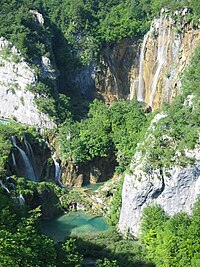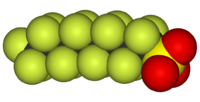
Quantification of sixteen cephalosporins in the aquatic environment by liquid chromatography-tandem mass spectrometry.
Sign Up to like & getrecommendations! Published in 2022 at "Journal of separation science"
DOI: 10.1002/jssc.202200481
Abstract: Antimicrobial agents are essential to protect human and animal health. During the COVID-19 pandemic, antimicrobials such as cephalosporins were widely used as prophylactics and to prevent bacterial co-infection. Undoubtedly, the prevalence of antibiotics in the aquatic… read more here.
Keywords: environment liquid; quantification sixteen; environment; cephalosporins aquatic ... See more keywords

Assessment of multiple anthropogenic contaminants and their potential genotoxicity in the aquatic environment of Plitvice Lakes National Park, Croatia
Sign Up to like & getrecommendations! Published in 2018 at "Environmental Monitoring and Assessment"
DOI: 10.1007/s10661-018-7028-1
Abstract: In this study, the influence of anthropogenic pollution on the aquatic environment of Plitvice Lakes National Park (PLNP) was investigated during 2011–2012 using a combination of chemical and cytogenetic analyses. Four groups of major contaminants… read more here.
Keywords: environment plitvice; water; plitvice lakes; lakes national ... See more keywords

Mathematical model for the transport of fluoroquinolone and its resistant bacteria in aquatic environment
Sign Up to like & getrecommendations! Published in 2017 at "Environmental Science and Pollution Research"
DOI: 10.1007/s11356-017-9848-x
Abstract: Development of antibiotic resistance in environmental bacteria is a direct threat to public health. Therefore, it becomes necessary to understand the fate and transport of antibiotic and its resistant bacteria. This paper presents a mathematical… read more here.
Keywords: transport; model; resistance; fluoroquinolone ... See more keywords

Biocide emissions from building materials during wet weather: identification of substances, mechanism of release and transfer to the aquatic environment
Sign Up to like & getrecommendations! Published in 2019 at "Environmental Science and Pollution Research"
DOI: 10.1007/s11356-019-06608-7
Abstract: Biocides are added to or applied on building materials to prevent microorganisms from growing on their surface or to treat them. They are leached into building runoff and contribute to diffuse contamination of receiving waters.… read more here.
Keywords: building materials; aquatic environment; receiving waters; biocide emissions ... See more keywords

Expression profile of genes involved in ramie flavonoids biosynthesis pathway and regulation of flavanone 3-hydroxylase (BnF3H) in response to aquatic environment
Sign Up to like & getrecommendations! Published in 2020 at "Acta Physiologiae Plantarum"
DOI: 10.1007/s11738-020-03036-w
Abstract: Flavonoids contained in ramie (Boehmeria nivea) root are important resources for officinal use. The plant seedling can grow optimally and develop an easy-harvesting adventitious root system in a hydroponic system. This research was carried out… read more here.
Keywords: biosynthesis; ramie roots; expression; flavonoid biosynthesis ... See more keywords

The role of analytical chemistry in exposure science: Focus on the aquatic environment.
Sign Up to like & getrecommendations! Published in 2019 at "Chemosphere"
DOI: 10.1016/j.chemosphere.2019.01.118
Abstract: Exposure science, in its broadest sense, studies the interactions between stressors (chemical, biological, and physical agents) and receptors (e.g. humans and other living organisms, and non-living items like buildings), together with the associated pathways and… read more here.
Keywords: chemistry; analytical chemistry; exposure science; aquatic environment ... See more keywords

Microplastics in aquatic environment: Challenges and perspectives.
Sign Up to like & getrecommendations! Published in 2021 at "Chemosphere"
DOI: 10.1016/j.chemosphere.2021.131151
Abstract: The occurrence of microplastics in the aquatic environment has become a growing concern globally. Microplastics pose a hazard to the ecological system, and their presence, particularly in the water, has an adverse impact on human… read more here.
Keywords: environment challenges; microplastics aquatic; water; environment ... See more keywords

Spatial (bio)accumulation of pharmaceuticals, illicit drugs, plasticisers, perfluorinated compounds and metabolites in river sediment, aquatic plants and benthic organisms.
Sign Up to like & getrecommendations! Published in 2018 at "Environmental pollution"
DOI: 10.1016/j.envpol.2017.11.090
Abstract: Organic contaminants such as pharmaceuticals, personal care products (PPCPs) and other emerging contaminants (ECs) are known to persist in the aquatic environment and many are indicated as endocrine, epigenetic, or other toxicants. Typically, the study… read more here.
Keywords: aquatic plants; accumulation; perfluorinated compounds; illicit drugs ... See more keywords

A circular toxicity approach to isoprostanes: From markers of oxidative stress, to epidemiological warning systems and agents of aquatic toxicity.
Sign Up to like & getrecommendations! Published in 2018 at "Environmental pollution"
DOI: 10.1016/j.envpol.2018.09.033
Abstract: Isoprostanes (IsoPs) are a class of oxidation products naturally formed in vivo that are indicative of endogenous oxidative stress. In individuals with chronic and oxidative stress related diseases, IsoPs are increased to pathological levels. Since they… read more here.
Keywords: aquatic environment; stress; circular toxicity; oxidative stress ... See more keywords

Are there pharmaceutical compounds in sediments or in water? Determination of the distribution coefficient of benzodiazepine drugs in aquatic environment.
Sign Up to like & getrecommendations! Published in 2019 at "Environmental pollution"
DOI: 10.1016/j.envpol.2019.05.015
Abstract: Alprazolam, clonazepam and diazepam are drugs belonging to the benzodiazepine class. These drugs might be important environmental contaminants in aquatic media. A total understanding of behavior and fate of drugs in aquatic environment is not… read more here.
Keywords: extraction; benzodiazepine; water; sediments water ... See more keywords

Toxic effects of NSAIDs in non-target species: A review from the perspective of the aquatic environment.
Sign Up to like & getrecommendations! Published in 2020 at "Environmental pollution"
DOI: 10.1016/j.envpol.2020.115891
Abstract: The presence of pharmaceuticals in the aquatic environment, both in marine and freshwater reservoirs, is a major concern of global environmental protection. Among the drugs that are most commonly used, NSAIDs tend to dominate. Currently,… read more here.
Keywords: aquatic animals; non target; toxic effects; aquatic environment ... See more keywords